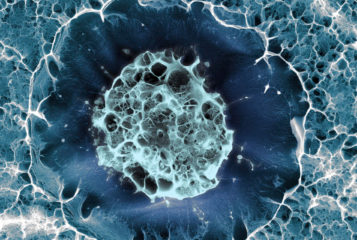A US woman who became infertile after cancer treatment has stunned doctors by becoming pregnant naturally, following a transplant of ovarian tissue into her abdomen. Ann Dauer, from Canton, Ohio has now given birth to a healthy baby girl, named Sienna. Mrs Dauer had one of her ovaries removed and frozen prior to having chemotherapy for Hodgkins lymphoma. In August 2004, after completing her treatment, Mrs Dauer had slices of ovarian tissue implanted under the skin of her abdomen.
Doctors at the Weill Cornell Medical Centre in New York had planned to remove eggs from the grafted tissue for use in IVF treatment, but Mrs Dauer conceived naturally just three months after the transplant. 'I did the ultrasound and almost fell off my chair', said team leader Kutluk Otkay. The pregnancy miscarried, but Mrs Dauer conceived naturally again the following month. 'Her treatment was almost guaranteed to make her menopausal', said Otkay, adding 'this really shouldn't have happened'.
Although two other women have given birth after frozen-thawed ovary transplants, one in Belgium and one in Israel, both had tissue transplanted in the ovary's normal position. In Mrs Dauer's case, the position of the graft should have made natural conception impossible. There are three possible explanations for the birth of Sienna Dauer: spontaneous recovery of natural fertility, recovery of the remaining ovary aided by hormones produced by the transplanted tissue and - most controversially - the 'reseeding' of the remaining ovary with ovarian stem cells.
Although some patients have regained their natural fertility following cancer treatment, the chances of Mrs Dauer doing so had been estimated as one in five million. But the chances of hormones from the transplanted tissue helping the remaining ovary recover are also thought to be low, since several other patients have undergone a similar procedure without conceiving naturally. The third explanation - that ovary stem cells travelled through the blood and 'kick-started' egg production in the remaining ovary - is controversial because the existence of such cells has not yet been proven.
Jonathan Tilly and his colleagues at Massachusetts General Hospital have found evidence of 'ovary stem cells' in mice - cells that are capable of producing fresh eggs throughout the animal's reproductive life. Earlier this year, they published a study suggesting that such cells originate in the bone marrow, rather than the ovaries themselves. 'It's just possible that the transplanted ovary supplied something that the damaged ovary didn't have, and that germ cells have moved through the blood to reseed it and allow it to start working again', said Otkay.
Although it is impossible to prove that the grafted ovary tissue somehow restarted egg production in Mrs Dauer's remaining ovary, Dr Otkay says that another of his patients has shown egg follicle development after having similar treatment. Professor Bill Ledger, of the University of Sheffield, told the Times newspaper that while spontaneous recovery was the most likely explanation, the stem cell theory was 'fascinating and credible'. 'It has a certain biological plausibility if the mouse work is accurate', he said.
Sources and References
-
A baby in five million
-
Nature's foundations may be shaken by baby for 'sterile' cancer survivor






Leave a Reply
You must be logged in to post a comment.